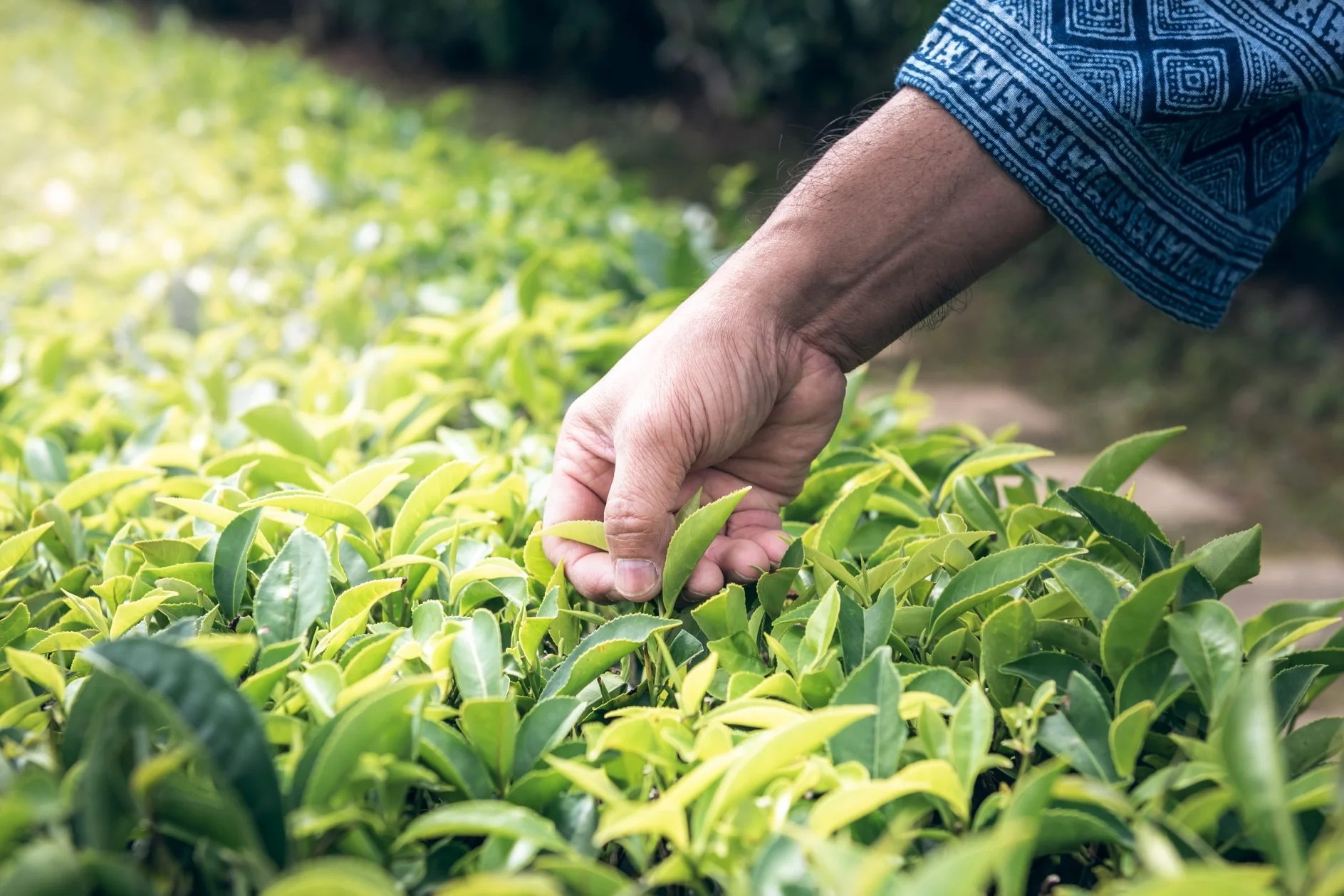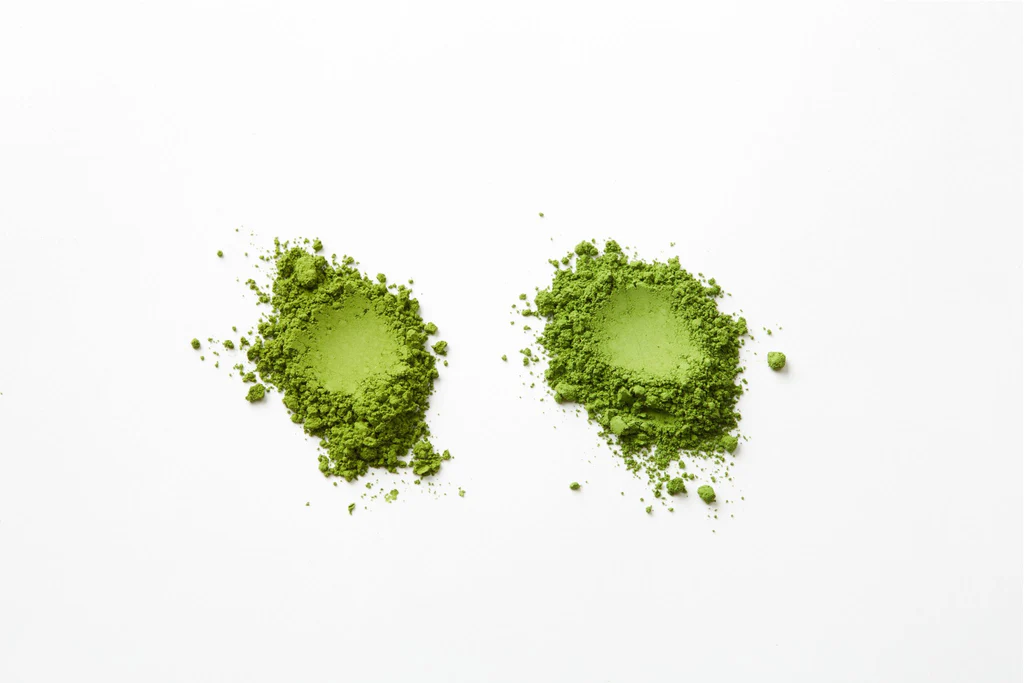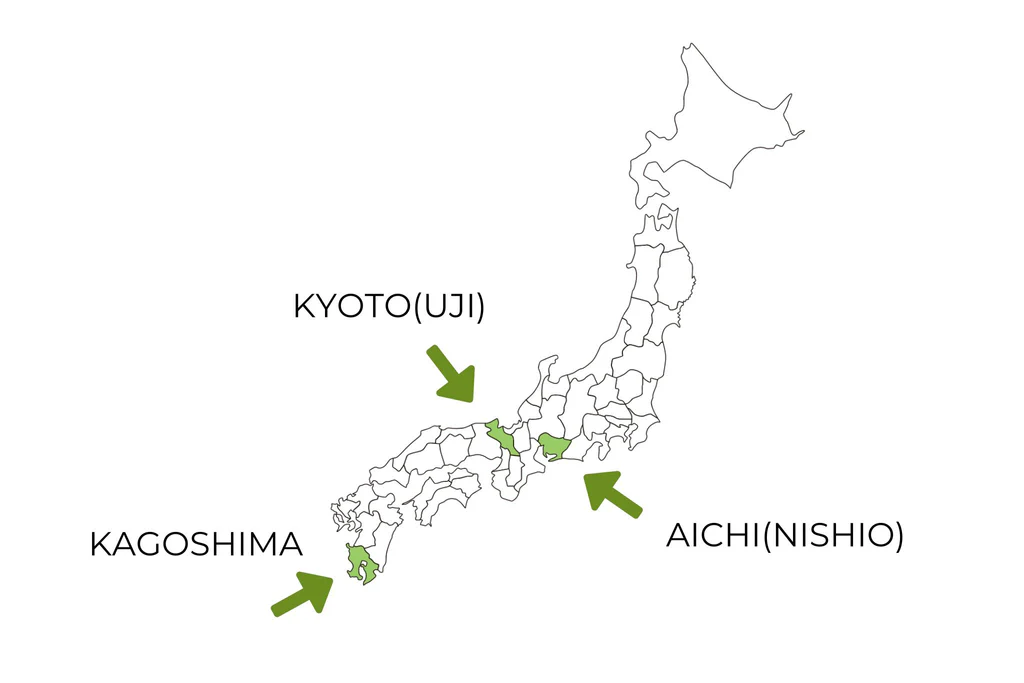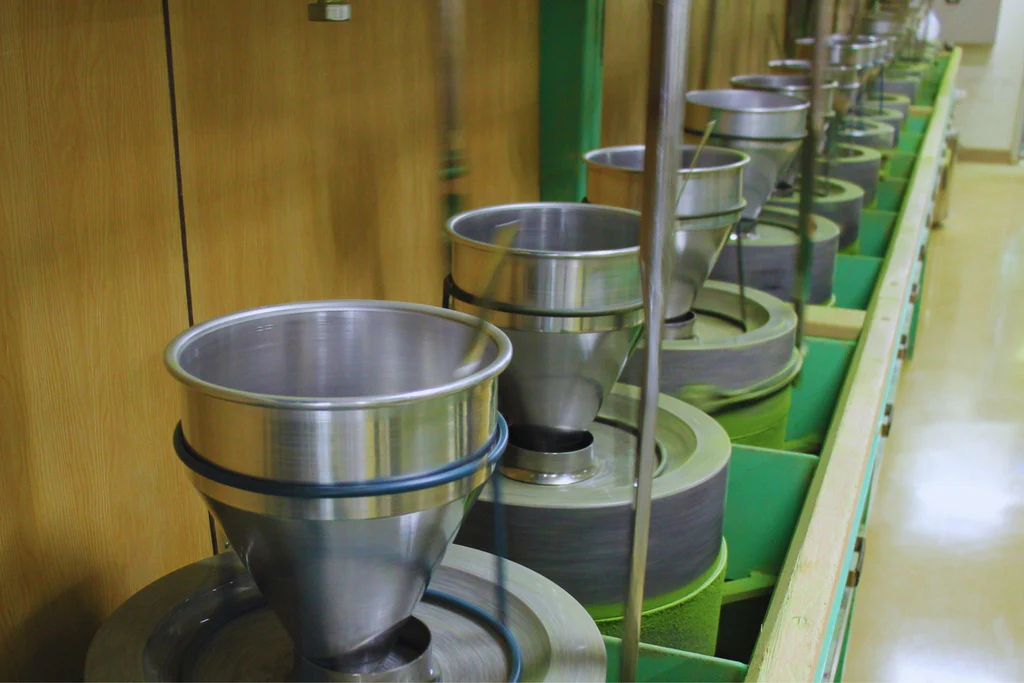Ik zal nooit mijn eerste smaak van slechte matcha vergeten. Ik was enthousiast om het levendige groene drankje te proberen waar iedereen het over had, maar wat ik kreeg was een bittere, stoffige teleurstelling. Het smaakte naar graspoeder en liet een korrelig laagje achter in mijn mond. Die ervaring stuurde me op een missie om te ontdekken wat Echt matcha zou moeten smaken.
In deze gids deel ik alles wat ik heb geleerd. We gaan verder dan de marketinghype en geven je de vijf onfeilbare tekenen om de heerlijke matcha van hoge kwaliteit te onderscheiden van het teleurstellende poeder van lage kwaliteit.
Wat is Matcha en waarom is kwaliteit zo belangrijk?
De kern, matcha is een fijngemalen poeder van speciaal gekweekte en verwerkte groene theebladeren, traditioneel uit Japan.. In tegenstelling tot gewone groene thee, waarbij je de blaadjes laat trekken en weggooit, consumeer je bij matcha het hele blad.
Dit is precies waarom kwaliteit niet onderhandelbaar is.

Een kopje matcha van hoge kwaliteit is allesbehalve slecht. Het is van nature zoet, romig en gevuld met een aangename, hartige smaak die bekend staat als umami. Het geeft een kalme, geconcentreerde energie dankzij een hoge concentratie van een aminozuur genaamd L-theanine.
Matcha van lage kwaliteit is daarentegen bitter en samentrekkend. Het mist het rijke voedingsstoffenprofiel - vooral de antioxidanten en L-theanine - dat matcha tot een gezonde krachtpatser maakt. Je krijgt niet alleen een slechte smaak; je mist ook de voordelen die je waarschijnlijk in de eerste plaats geïnteresseerd hebben gemaakt in matcha.
De 5 betrouwbare aanwijzingen voor Matcha-poeder van hoge kwaliteit
Vergeet al het andere even. Om een zelfverzekerde matchakoper te worden, hoef je alleen maar je zintuigen te trainen om op deze vijf belangrijke indicatoren te letten.
Bord 1: Kleur - Een levendig, elektrisch groen
Waar moet je op letten? Het meest directe teken van kwaliteit is de kleur. Goed matchapoeder moet een levendige, bijna elektrische juweeltint hebben.
Waarom het belangrijk is: Deze schitterende kleur komt van een hoog gehalte chlorofyl. Echte matcha wordt gemaakt van theebladeren die in de schaduw geteeld ongeveer drie tot vier weken voor de oogst. Dit proces dwingt de plant tot een overproductie van chlorofyl en L-theanine, wat resulteert in die kenmerkende levendige groene tint en een diepe, complexe smaak.
Rode vlag: Wees op je hoede voor poeders die dof, drassig groen zijn, of erger nog, gelige of bruinachtige tinten hebben. Dit duidt erop dat de bladeren ouder waren, niet goed gearceerd, inclusief stengels en nerven, of geoxideerd zijn doordat ze oud of slecht bewaard zijn.
Praktisch toepasbare tip: Denk aan de kleur van verse voorjaarserwten of nieuwe dennennaalden. Als het poeder voor je niet die levendige, levendige kleur heeft, dan is het niet het juiste.

Teken 2: Textuur - Een fijn, zijdeachtig poeder
Waar moet je op letten? Matcha van hoge kwaliteit moet een hele fijne, zijdeachtige textuur hebben, vergelijkbaar met talkpoeder of oogschaduw.
Waarom het belangrijk is: Traditioneel wordt matcha gemalen op langzaam bewegende stenen molens. Dit nauwgezette proces breekt de theebladeren (genaamd tencha) gereduceerd tot microscopisch kleine deeltjes, meestal slechts 5-10 micron groot. Dankzij deze fijnheid zweeft de matcha soepel in water en ontstaat er een romige, schuimige drank zonder gruis.
Rode vlag: Als het poeder grof of korrelig aanvoelt wanneer je het tussen je vingers wrijft, is het waarschijnlijk machinaal gemalen op een hoge temperatuur, waardoor de tere blaadjes verschroeien en hun smaak verloren gaat. Het zal niet goed kloppen en resulteren in een zanderige textuur op de bodem van je kopje.
Praktisch toepasbare tip: Neem een klein kneepje en wrijf het tussen je duim en wijsvinger. Het moet uitzonderlijk glad aanvoelen en een schone, stevige groene lijn op je huid achterlaten.
Teken 3: Herkomst - Afkomstig uit Japan
Waar moet je op letten? Authentieke matcha van hoge kwaliteit komt uit Japan. Op de verpakking moet duidelijk de herkomst staan, en topmerken noemen vaak de specifieke regio.
Waarom het belangrijk is: Japan heeft de kunst van de matchateelt eeuwenlang geperfectioneerd. Regio's zoals Uji (bij Kyoto), Nishio (in Aichi)en Yame (in Fukuoka) staan bekend om de productie van de beste theeën van het land. Ze beschikken over het ideale klimaat, de ideale bodem en de generatiekennis die nodig is voor het telen in de schaduw en het malen met stenen.
Rode vlag: Hoewel andere landen nu "groene theepoeder" produceren, is het zelden echte matcha. Deze poeders slaan vaak het kritieke schaduwgroeiproces over en gebruiken andere maalmethoden, wat resulteert in een product dat fundamenteel verschilt in smaak, textuur en voedingswaarde.
Praktisch toepasbare tip: Controleer het etiket. Als er niet "Product van Japan" op staat, kun je beter sceptisch zijn. Zoek naar Uji matcha voor een klassiek, goed afgerond smaakprofiel dat perfect is voor beginners.

Teken 4: Aroma & Smaak - Zoet, plantaardig en vol Umami
Waar moet je op letten? Nog voor je het proeft, moet het aroma al uitnodigend zijn. Goede matcha heeft een frisse, zoete en complexe plantaardige geur. Wanneer je het proeft, moet de smaak zacht, mild en gedomineerd worden door die hartige geur. umami noot, gevolgd door een aanhoudende, subtiel zoete afdronk.
Waarom het belangrijk is: De umami-smaak komt van de hoge concentratie L-theanine die tijdens het schaduwproces wordt ontwikkeld. Dit is de kenmerkende smaak van matcha van hoge kwaliteit. De bittere smaak komt van de catechines, die meer uitgesproken zijn in bladeren die in de volle zon groeien.
Rode vlag: Een sterke, bittere of samentrekkende smaak is het duidelijkste teken van matcha van lage kwaliteit. Als het poeder stoffig, muf of naar hooi ruikt, is het waarschijnlijk oud of slecht verwerkt.
Praktisch toepasbare tip: Echte matcha van hoge kwaliteit is zo zacht en smaakvol dat je er alleen heet water bij hoeft te drinken en weinig tot geen zoetstof nodig hebt. Als je merkt dat je veel suiker of melk moet toevoegen om het lekker te maken, drink je waarschijnlijk een product van een lagere kwaliteit.
Teken 5: Schuim (De "Chasen"-test) - Een rijk, romig schuim
Waar moet je op letten? Als je het op de juiste manier opklopt met een bamboe garde (chasen) produceert goede matcha een dikke, romige laag van kleine, stabiele belletjes, bekend als microschuim.
Waarom het belangrijk is: De fijne deeltjesgrootte en chemische samenstelling van gemalen matcha zorgen ervoor dat het in het water zweeft en lucht vasthoudt wanneer het wordt geroerd. Dit schuim is niet alleen voor de show; het is een integraal onderdeel van de matcha-ervaring en geeft het een zacht, romig mondgevoel dat de resterende hints van wrangheid verzacht.
Rode vlag: Matcha van lage kwaliteit heeft moeite met opschuimen. Je kunt een paar grote, zeepachtige bellen krijgen die vrijwel onmiddellijk verdwijnen. Dit duidt op een grove maling en een onvermogen om goed op te lossen in het water.
Praktisch toepasbare tip: Gebruik heet maar niet kokend water (ongeveer 80°C). Klop krachtig in een "W" of "M" beweging gedurende ongeveer 20-30 seconden. Het resultaat moet een mooie, consistente schuimlaag zijn die het hele oppervlak bedekt.
De etiketten ontcijferen: Ceremonieel vs. culinair uitgelegd
Je zult deze twee termen overal tegenkomen, en ze begrijpen is de sleutel tot het kopen van de juiste matcha voor jouw behoeften.
- Ceremoniële rang: Dit is matcha van de hoogste kwaliteit, gemaakt van de jongste, tederste theeblaadjes van de top van de plant. Het heeft de meest levendige kleur en de zachtste, meest delicate umami-smaak.
- Geschikt voor: Alleen drinken met heet water (usucha of koicha). Het gebruik van deze kwaliteit voor lattes of bakken is zonde van de genuanceerde smaak (en van je geld).
- Culinaire graad: Dit is een bredere categorie matcha gemaakt van iets oudere, rijpere bladeren. Het heeft een robuuster, iets bitterder smaakprofiel dat is ontworpen om andere ingrediënten te weerstaan.
- Geschikt voor: Lattes, smoothies, ijs en baksels. Het geeft je recepten een prachtige groene kleur en een duidelijke matchasmaak zonder dat het verloren gaat.
De mythe ontkrachten: Wees op je hoede voor termen als "Premium Grade", "Cafe Grade" of "Classic Grade". Dit zijn geen officiële classificaties. Het zijn marketingtermen gecreëerd door merken en kunnen van alles betekenen. Houd je aan het duidelijke onderscheid tussen Ceremonieel en Culinair om een weloverwogen keuze te maken.
Veelgestelde vragen over Matcha-kwaliteit
Waarom is goede matcha zo duur? De prijs weerspiegelt het arbeidsintensieve proces: wekenlange schaduwteelt, zorgvuldige handpluk van alleen de jongste blaadjes en het extreem langzame stenen maalproces. Het kan wel een uur duren om slechts 30 gram matcha van ceremoniële kwaliteit te malen.
Hoe moet ik mijn matcha bewaren om het vers te houden? Matcha is gevoelig voor licht, warmte en lucht. Bewaar Matcha na opening in een luchtdichte verpakking in de koelkast. Probeer het binnen één tot twee maanden te consumeren voor de beste smaak en kleur.
Kan ik Ceremonial Grade gebruiken voor lattes? Dat kan, maar het is niet aan te raden. De delicate, genuanceerde smaken van ceremoniële matcha worden overstemd door melk en zoetstoffen. Het is veel rendabeler om een culinaire kwaliteit van goede kwaliteit te gebruiken voor mixdrankjes.

Je eerste stap naar een perfecte kop Matcha
Het kiezen van je eerste matcha hoeft niet intimiderend te zijn. Nu je gewapend bent met deze kennis, kun je vol vertrouwen door de opties navigeren en een poeder vinden dat de authentieke, lonende ervaring biedt die je verdient.
Hier is je laatste checklist:
- Kleur: Is het levendig, elektrisch groen?
- Textuur: Voelt het fijn en zijdeachtig aan?
- Oorsprong: Komt het uit Japan?
- Smaak: Belooft de beschrijving een zoete, umami-smaak?
- Rang: Kies je voor Ceremonial om te drinken of Culinary om te mixen?
Begin met een klein blikje matcha van ceremoniële kwaliteit van 30 gram van een gerenommeerde leverancier. Het is de perfecte manier om kennis te maken met de echte smaak van deze ongelooflijke thee. Geniet van de reis.



